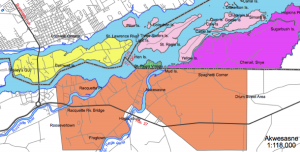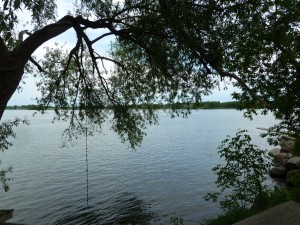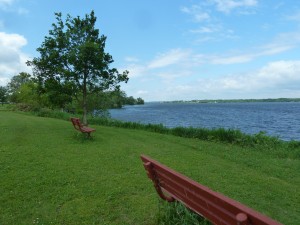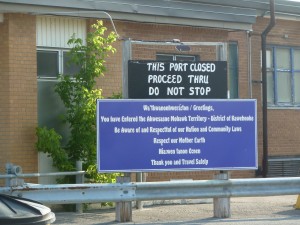I wake up, get ready for work, and am on my way to Akwesasne, a large Indigenous community straddling the borders between Ontario, Quebec, and New York. I have been working for the past two months at their Justice Department. I drive towards the Seaway International Bridge in Cornwall, Ontario. The toll bridge, located within Canada, is operated by the Seaway International Bridge Corporation, and separates the Akweasne District of Kawehnoke (Cornwall Island) from Cornwall. While Akwesasne community members are not required to pay the toll, it has had an economic impact, since Canadian businesses are less likely to do business in the community when they have to pay to get across. Some restaurants will deliver to the tollbooth rather than driving onto the island.
I cross the bridge and drive across Cornwall Island, the most westerly part of Akwesasne. I pass signs telling me I’m on Indian land, and others calling for an inquiry into missing and murdered Indigenous women. I drive past an old Canadian Border Services point, moved in 2009 and currently being demolished. I quickly arrive at the next bridge, which brings me to the American border.

Yellow: Kawehnoke (Cornwall Island), Ontario
Green: Kanatakon (St. Regis Villange), Quebec
Bright pink: TsiSnaihne (Snye), Quebec
Light pink: generally uninhabited islands
Orange: St. Regis Mohawk Reservation (governed by the St. Regis Mohawk Tribal Council)
While I live and work in Canada, the unique geography of Akwesasne requires that I cross into the United States and drive back over the international border within the Mohawk Territory to get from Cornwall, Ontario to Kanatakon (St. Regis Village), Quebec. The location of the border has had a deep-seated impact on the community. It affects everything from service delivery, to policing, to politics and government. At the very basic level, it means that there are two separate Indigenous governments operating on the Mohawk territory: the Mohawk Council of Akwesasne, which governs the Districts within Canada’s borders, and the St. Regis Mohawk Tribal Council, which governs the territory within the United States. Many community members have identification from both countries and live and work in different parts of the territory.
I pull up to the American border. It’s not busy and takes only a few minutes to get through. I continue on my drive and pass a Tribal Police car. Policing in and around the territory is demonstrative of the complex jurisdictional issues. The Tribal Police operate on the American reservation while the Akwesasne Mohawk Police operate on the Canadian reserve. They cooperate with a number of police forces, including the two border agencies, the Cornwall Police, the Ontario Provincial Police, the RCMP, and the New York State Police, to name only a few. At a conference, the Chief of the Akwesasne Mohawk Police told a story about a murder that happened in a house that sits on the border. In order to decide whether they or the Tribal Police would have jurisdiction, they had to see where in the house the body was found, and even considered whether that was actually where the crime had taken place, or whether the body had fallen or been moved onto that side of the border.
I continue on my drive and turn north again towards the district of Kanatakon. The speed limit changes from 35mph to 40km/h, offering the only sign that I have crossed the Canadian border. Kanatakon is a beautiful point reaching out into the St. Lawrence. At lunch, I eat outside and enjoy the view.


After an interesting day at work, I drive home. This direction is more cumbersome than the way into work. “Technically” (to quote a U.S. Border Patrol Agent) I have to park and check in at the American Border since I crossed into the US at an unmanned point when I left Kanatakon. After driving across the American bridge, I pass the abandoned CBSA checkpoint, which is currently being demolished. My coworkers have explained to me that in 2009, Canada wanted to arm their border agents, and the Mohawk Council of Akwesasne opposed having armed agents on their territory. After protests, the CBSA (with their newly armed agents) moved over to Cornwall. From what I have heard, Council’s actions have been met with mixed reactions in the community, largely because of the inconvenience suffered by members as a result. They still have to go through customs when driving onto Cornwall Island, but now the process is longer since they have to drive across the Canadian bridge to do so. They also have to pass through Canadian Border Services when driving from Cornwall Island to Cornwall. Hundreds of community members have had their cars impounded for stopping on the Island without going through customs. From my personal point of view, it seems like an overly burdensome requirement to place on community members driving from one part of the territory to another, especially when other unique Canadian border crossings have experimented with other solutions (see, for example, this story about a community in BC).

Akwesasne is a complicated place. As an Indigenous community in Canada, they are working towards self-determination and moving past some of the ongoing harms of colonialism. As a border community, they face many unique challenges and jurisdictional issues. And like any other community, they are made up of many different people with their own views and goals. Almost two months into my internship, I am still learning new things about how the community works. There are many hardworking people at the Justice department and elsewhere who are coming up with creative solutions to their challenges, and it’s exciting to see such a dynamic community in action.

